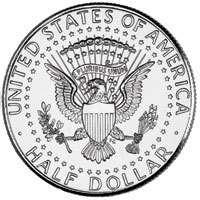The half dollar, a stalwart in American currency, has witnessed centuries of economic evolution and societal changes. From its humble beginnings in the early years of the United States to the diverse designs and denominations it boasts today, the half dollar has etched its place in the annals of numismatic history. This article explores the intriguing journey of the half dollar, from its inception to the modern era.

Kennedy Half Dollar (1964-Now)
Franklin Half Dollar (1948-1963)
Liberty Walking half dollar (1916-1947)
Barber Half Dollar (1892-1915)
Seated Liberty Half Dollar (1839-1891)
Early Half Dollars (1794-1839)
Early Days and Circulation:
The history of the half dollar can be traced back to the Coinage Act of 1792, which established the U.S. Mint. The first half dollars, minted in 1794 and 1795, featured the Flowing Hair design, portraying Liberty on the obverse and an eagle on the reverse. This marked the beginning of a numismatic legacy that would endure for centuries.
As the 19th century unfolded, the half dollar underwent several design changes, including the Draped Bust, Capped Bust, and Seated Liberty motifs. These designs reflected the artistic and cultural influences of their respective eras, providing a visual journey through American history.
The Civil War and Silver Half Dollars:
The mid-19th century saw the issuance of the Seated Liberty Half Dollar, a design that endured through the Civil War. However, as the conflict unfolded, the demand for circulating coinage increased, leading to the introduction of the silver Seated Liberty Half Dollar in greater quantities.
In 1866, the introduction of the new design, featuring a shield on the obverse and an eagle on the reverse, signaled a departure from the previous motifs. This heralded the era of a more standardized appearance for the half dollar.
The Barber Half Dollar:
With the turn of the century, the Barber Half Dollar emerged, featuring the design by Chief Engraver Charles E. Barber. Struck from 1892 to 1915, the Barber Half Dollar showcased Lady Liberty on the obverse and an eagle on the reverse. This design transitioned seamlessly into the early 20th century, maintaining a semblance of continuity in American coinage.
The Walking Liberty Half Dollar:
One of the most iconic designs in the history of the half dollar emerged in 1916 with the Walking Liberty motif. Created by sculptor Adolph A. Weinman, this design showcased Lady Liberty striding confidently on the obverse, draped in the American flag, and a majestic eagle on the reverse. The Walking Liberty Half Dollar remains a favorite among collectors for its artistic elegance and patriotic symbolism.
Silver Shortages and the Kennedy Half Dollar:
As the demand for silver increased and silver reserves dwindled in the 1960s, the composition of the half dollar underwent a significant change. In 1964, the Kennedy Half Dollar was introduced, featuring the likeness of President John F. Kennedy on the obverse. This marked the first time a portrait of a real person appeared on regular-issue circulating U.S. coinage.
The Kennedy Half Dollar, initially minted in 90% silver, transitioned to a copper-nickel composition in 1971. Despite the change in metal content, the Kennedy Half Dollar remains a popular and widely circulated coin.
Modern Era and Commemorative Issues:
In recent decades, the half dollar has become a canvas for commemorative issues, celebrating important events and individuals in American history. From the bicentennial designs in 1976 to various commemorative releases, the half dollar continues to adapt to the evolving cultural landscape.
The Future of the Half Dollar:
While the half dollar is less prevalent in everyday transactions today, it maintains its significance in the numismatic world. The evolution of designs, changes in metal content, and the issuance of commemorative coins reflect the adaptability of the half dollar to the dynamic needs and preferences of American society.
The half dollar’s history is a captivating narrative that mirrors the growth and transformation of the United States. From the early days of the Flowing Hair design to the enduring legacy of the Kennedy Half Dollar, each iteration of this coin tells a story of innovation, resilience, and cultural expression. As the half dollar continues its journey into the future, it remains a fascinating piece of American numismatic heritage, linking the past, present, and future in the hands of collectors and enthusiasts alike.
